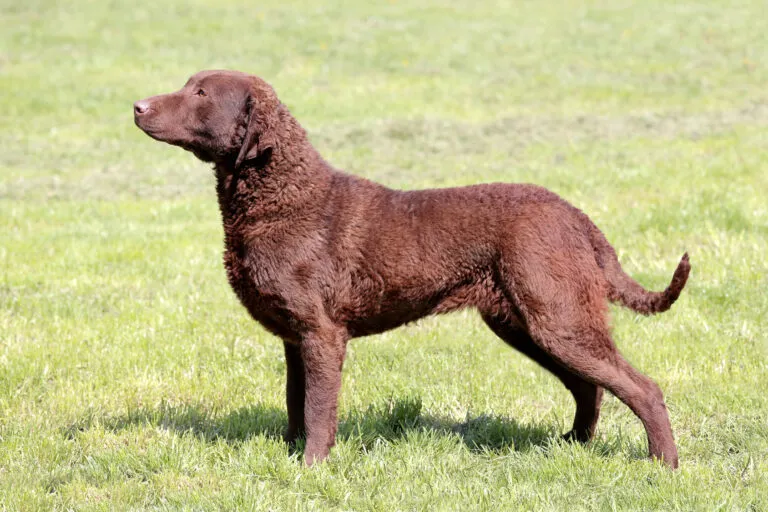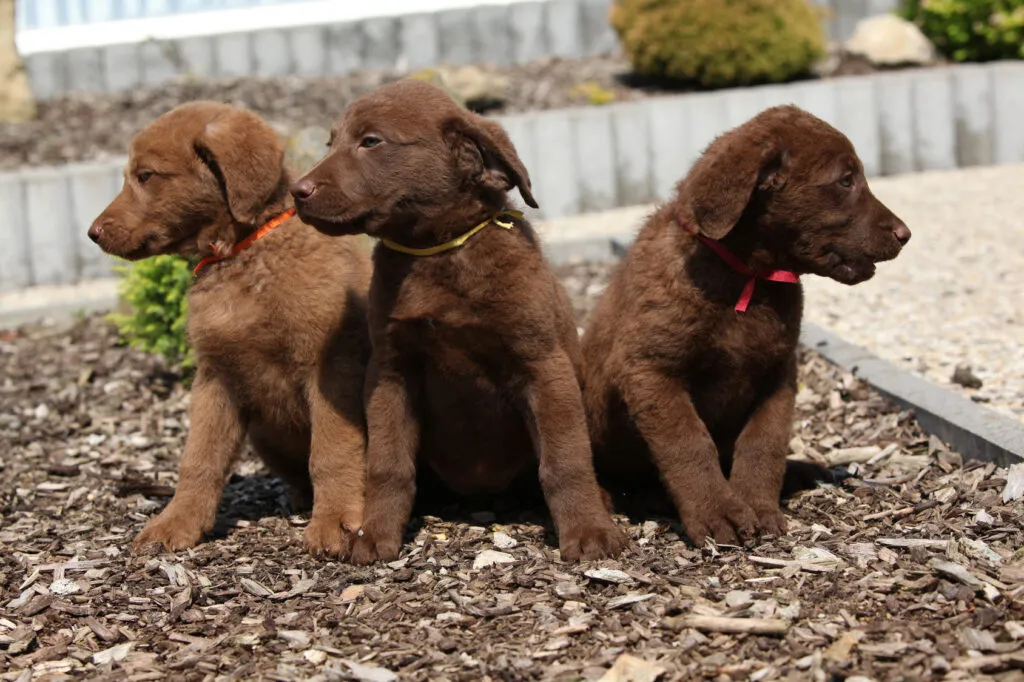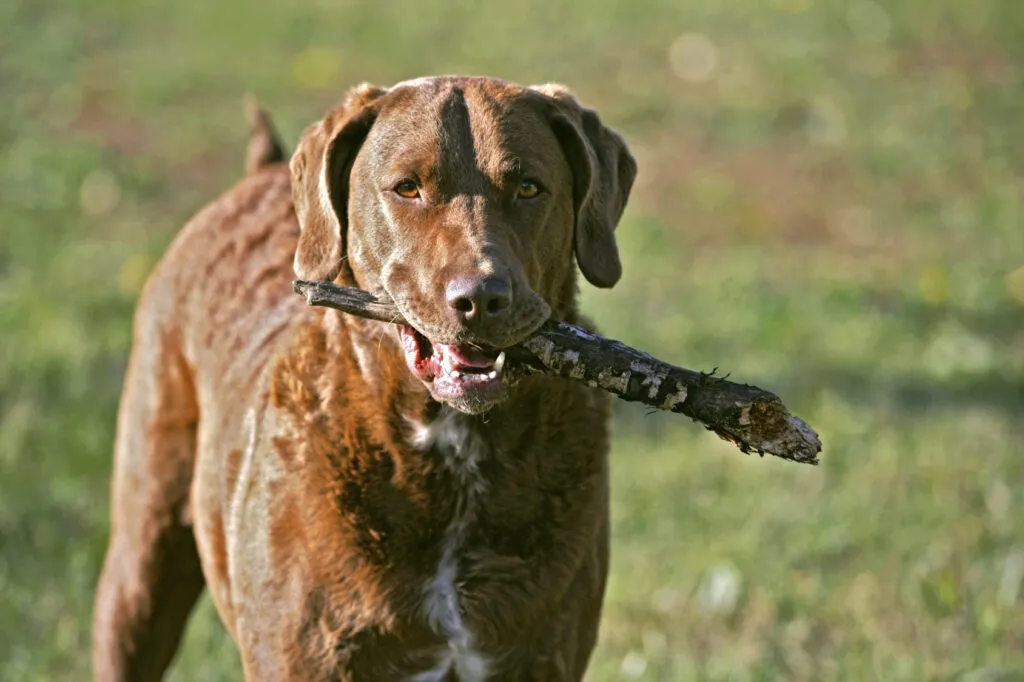Medium Size Poodle
This strong and sturdy retriever gets its name from its place of origin, Chesapeake Bay, in the US state of Maryland. Originally bred for waterfowl hunting, the Chessie still stands out today for its courage, endurance, and toughness. Unlike other retriever breeds, it also possesses a pronounced guarding and protective instinct.

© Vincent / stock.adobe.com
The Chesapeake Bay Retriever’s dense, slightly oily coat protects it in icy waters. Coat colours range from deadgrass to various brown shades
The Chesapeake Bay Retriever is every employer’s dream: the dedication, determination, and endurance it shows in its tasks would make many look on in envy. The delight with which the Chessie tackles its assigned duties is almost contagious. No task is too much, no water too cold, no brush too thick, and no duck too heavy.
This “worker” among retrievers is not only a passionate and valuable hunting assistant but also a brave guard and protection dog as well as a talented rescue dog. As a hunting dog, it showcases its skills primarily in waterfowl hunting: breaking through ice, swimming in icy waters, and even diving after prey.
The Chesapeake doesn’t give up until it has retrieved the duck or goose to its handler. Additionally, this hard-working retriever, with its keen sense of smell, is excellent as a flushing and tracking dog.
As tough and independent as the Chesapeake appears at work, it is equally sensitive. It forms a very close and intense bond with its family, particularly with its main caregiver. It is friendly, good-natured, and loves children, as one would expect from a retriever.
Nevertheless, it can also be quite stubborn—an uncommon trait for a retriever.
Originally a working dog, it is used to working independently and making its own decisions. Its intelligence and self-confidence can sometimes make it question the rationale of some training attempts and commands, occasionally leading it to go its own way.
However, a leader who recognises its work enthusiasm and assigns it tasks that challenge it both physically and mentally will find the Chessie to be an eager and willing follower.
A Chesapeake Bay Retriever that is not allowed to work can quickly become a problem dog. The role of a family dog, which many of its retriever colleagues embrace enthusiastically, does not fulfil this work-oriented hunting dog.
If you do not set it hunting tasks, you should at least entrust it with the role of a guard dog. Unlike other retriever breeds, the vigilant Chessie displays a pronounced protective behaviour. However, this trait can also lead to problems. In the absence of sufficient work, some Chesapeakes may become overly protective of their territory and bark at every visitor, even the mail carrier, which can be a nerve-wracking experience for both the owner and the neighbours.
With consistent training from an experienced handler, early socialisation, and plenty of physical activity, this behaviour can be curbed.
The Chesapeake Bay Retriever’s history as a working dog is evident in its appearance. With a shoulder height of up to 66cm in males and 61cm in females, the weight often exceeds 36kg and 32kg respectively.
This clearly positions it among the larger and heavier retriever breeds. Its well-muscled body is perfectly adapted to various working conditions. Consequently, different types have developed within the breed: a compact type, a sporty, long-legged type, and a large, robust type.
Just as the Chesapeake’s work has influenced its structure, so too has the colour and texture of its fur adapted to its environment. Like most retriever breeds, a solid coat colour is often preferred, though the colour palette for this breed is relatively broad.
It ranges from light deadgrass and dark deadgrass (a dried-grass tone) to a light red (sedge), a greyish brown (tan), and various shades of brown (light brown, brown, dark brown). The short, dense fur, which often appears slightly oily, is extremely water-repellent due to its structure and the very dense undercoat, enabling the Chesapeake to swim tirelessly even in icy water.
The dense coat from the neck along the back to the rod is slightly wavy. On the head, belly, and legs, it is smooth.
The eye colour should match the fur and is usually amber or light brown. What stands out about the breed, however, is its expression and range of vocalisations, sometimes making these “talking” Chesapeakes particularly notable. From the highly raised lips resembling a broad grin to the vocal sounds that can seem like cooing, growling, yodelling, or even singing.
Among retrievers, the Chesapeake is an exotic breed—not just in terms of its guarding instincts or vocalisations but also its origin. It is the only retriever breed originating in America. While its precise history remains unclear, legend has it that its beginnings trace back to two St.-John’s-Newfoundland dogs, which were stranded with a ship in Chesapeake Bay, Maryland, in 1807.
 © zuzule / stock.adobe.com
© zuzule / stock.adobe.com
“Sailor,” a reddish male, and “Canton,” a black female, had endured hours in icy water before being rescued by locals. Impressed by their endurance and water skills, the locals trained the two Newfoundlands as duck-retrievers. While Sailor and Canton were never mated, they are considered the progenitors of today’s Chesapeake Bay Retriever.
Cynologists believe the breed, first registered with the American Kennel Club in 1878, likely resulted from crossing various breeds, including the Flat-Coated Retriever, the Curly-Coated Retriever, the Irish Water Spaniel, and various setters and coonhounds.
In its American homeland, the Chesapeake is well-known beyond Maryland. As an enthusiastic hunting assistant, tireless retriever, brave guard dog, and sporty companion for experienced handlers, it enjoys growing popularity.
However, it also finds an increasing number of admirers in Europe. If you’re interested in the breed, you should first contact an official retriever club, which can provide breeder addresses domestically and abroad. A great opportunity to meet the breed and connect with other Chesapeake owners are the annual Chessie meetings in several European countries, including Germany, Austria, the Netherlands, and the UK.
Before deciding to buy a puppy, ensure the Chesapeake Bay Retriever is indeed the right breed for you. As described, the American hunting utility dog is not an ordinary retriever or a typical family dog. It requires substantial know-how, consistency, and especially time to keep this athletic and work-driven companion sufficiently occupied and well-trained.
Discuss with your breeder the role the dog will play in your family and how you envision your future with a Chesapeake. A reputable breeder following FCI rules will support you with advice and willingly provide information about the breed and their dogs. This may also include advising against purchasing this breed. The current puppy price for a purebred Chesapeake from a reputable breeding line is £1,000 upwards.
A significant advantage of buying a puppy from reputable breeding is the health of the animals. Before being approved for breeding, a Chesapeake undergoes various tests, including a behaviour test, a companion dog exam, and a dummy or advanced hunting test.
They are also screened for hereditary diseases such as hip dysplasia (HD), elbow dysplasia (ED), and eye diseases. Before joining their new families, puppies are also vaccinated, dewormed multiple times, and chipped. Veterinary costs for the Chesapeake, generally regarded as very robust and healthy, are usually manageable.
A dog’s health is not solely determined by its genetic makeup. Various other factors are crucial for its well-being and vitality, with diet being one of the most impactful. Incorrect nutrition can trigger many ailments, far beyond the issue of overweight.
Conversely, a healthy diet can prevent many diseases, alleviate existing issues, and significantly contribute to a dog’s well-being. This is especially true for the Chesapeake’s diet.
Like many other large breeds, the Chessie is prone to joint problems (e.g., HD or ED). As a young dog in the growth phase, it should receive food suitable for its age and activity level. If the food is too rich, it can lead to rapid bone growth. Cartilage and ligaments aren’t yet stable enough to support the heavy bones, leading to future skeletal diseases. Joint and bone problems can also arise from an improper calcium-phosphorus ratio in the food.
Therefore, the nutrient content of the diet should be tailored to the actual needs of the dog, not only during puppyhood but also for an adult dog.
 © rima15 / stock.adobe.com
© rima15 / stock.adobe.com
While dog nutrition predominantly consists of meat (approx. 70% to 80%), the freshness, type, and source of the meat, along with the addition of vegetables, rice, or flakes, significantly influence the supply of essential nutrients, minerals, and vitamins.
To ensure your Chesapeake gets what it needs, it is important to understand its specific needs. These can vary from dog to dog—after all, a Chessie that swims daily to retrieve ducks has a higher energy requirement than one that merely guards the house and yard.
The care of a Chesapeake is relatively straightforward. Chessies are known for their resilience, and their short, dense coat is equally robust, effectively repelling dirt and water. However, regular brushing is recommended to remove dead hair and ventilate the undercoat containing oil.
Additionally, you should regularly check and clean eyes, ears, and paws to detect and prevent potential infections.
Compared to feeding and grooming, occupying a Chesapeake certainly takes the most effort. As a born “working dog,” this breed demands meaningful tasks that challenge it both physically and mentally for several hours daily.
Extensive walks, cycling and jogging trips, or outings to the lake are important but surely not enough. Owners who don’t use them for hunting should offer suitable alternative activities. Regular retrieval training on land and in water, preferably with dummies, or training as a rescue dog, as well as dog sports (e.g., agility), are possible solutions.
It’s important to cater to the Chessie’s preferences, its retrieval drive, its hunting instinct, and its love for water regularly.
A detached house in the countryside with a large, fenced garden suits the freedom-loving and nature-oriented Chessie. A nearby water source, like a pond or stream, it can jump into at will would be ideal for this water-loving dog.
In the city, a Chesapeake is likely to feel uncomfortable. Its pronounced guarding instinct and the impulse to “report” every neighbour passing by can quickly become an issue in the city’s confined spaces. In the countryside, however, it’s best to let it guard the house and yard.
The Chesapeake Bay Retriever is primarily a working dog. Beginners or families seeking an easy-going companion dog should consider other retriever breeds. Although the Chesapeake is indeed willing to learn and be obedient, it must be adequately exercised and its work drive must be taken seriously. It needs a clear hierarchy from a young age.
The Chesapeake is more of a “one-person dog,” strongly attached to one caregiver. While it tolerates and protects other family members, it does not necessarily obey commands from them. Temporary handover to another handler, for example during holidays, can thus be challenging.
Additionally, the Chesapeake is not naturally inclined to wait—it prefers to work. Therefore, it must learn that the owner sets the daily routine. A regular schedule with fixed times for eating, resting, and working gives it structure and helps tame its exuberant temperament.
Positive early socialisation is also essential to channel its guarding and protective instincts. The more exposure it has to other dogs, animals, and people, the less likely it is to be unsettled or suspicious later on.
If you love the Chesapeake Bay Retriever, you might also be interested in:
Fans of the Bearded Collie agree that those who aren't familiar with this dog breed simply have to get acquainted with it. And those who have experienced how a Bearded Collie bolts across meadows with its flowing fur, how it rolls around full of energy and joy and how it attentively and observantly takes into account its owners wishes become simply addicted to this original dog breed and its unique charm.
The Goldendoodle isn't a breed, but a pairing between Golden Retrievers and Medium or Standard Poodles. Marketed as a low-maintenance dog for allergy sufferers, this hybrid is enjoying increasing popularity amongst dog lovers, similar to the Labradoodle.